DMM Brymen BM869s
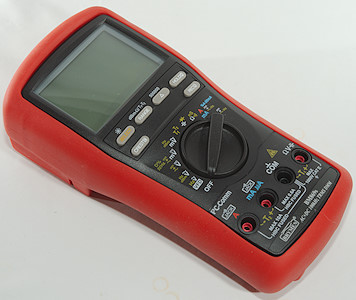
This is the top Brymen meter with very high precision and PC connection (Must be bought separately).
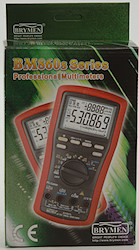

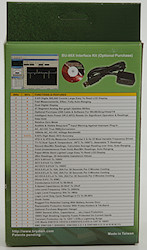

The meter arrived in a cardboard box that is used for the two top models, on the back is a table comparing them.
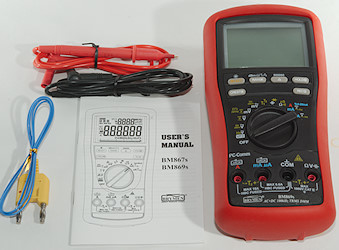
The box included the meter, two probes, a thermocoupler (Meter supports two) and the manual (It can also be downloaded).



Probes are branded with B.T.C. and has removable tip covers.
The probes are rated for up to CAT IV 1000V like the meter.

The plug is fully shrouded and standard probe plug size.

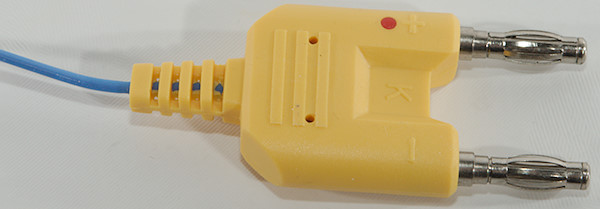
A standard thermocoupler with a standard dual banana connector.
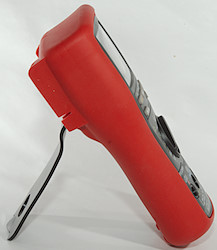
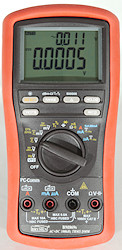
The meter is heavy and the tilting bale can hold it while the range switch is used or the buttons is pressed.
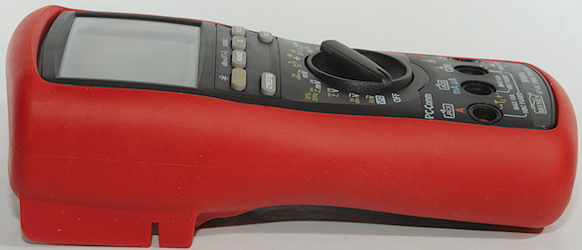
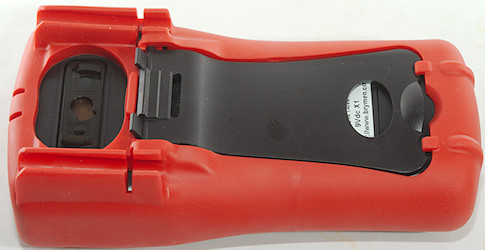
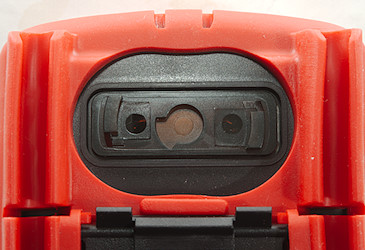
The PC connection is here with an optical link.
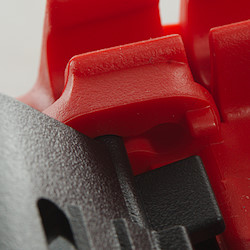
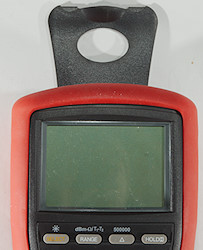
The tilting bale can be moved a bit and then be used to hand the meter on.

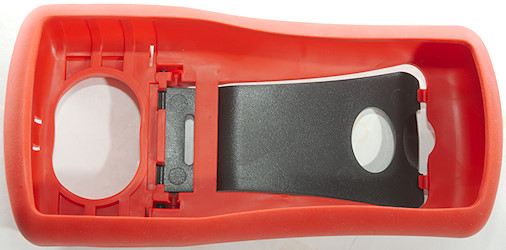
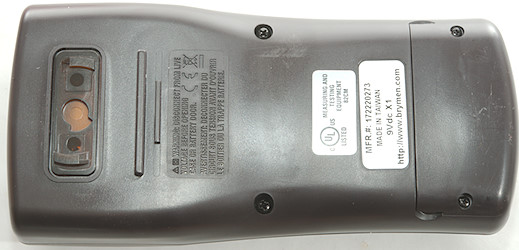
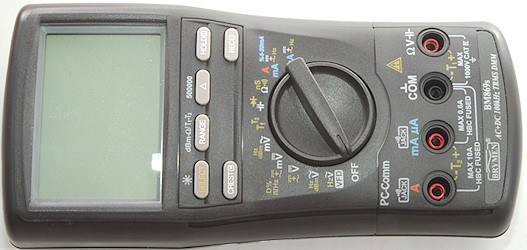
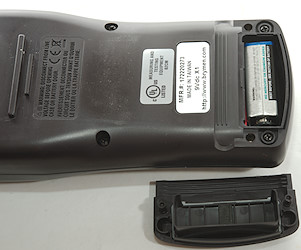
The rubber sleeve must be removed to replace the battery
Display
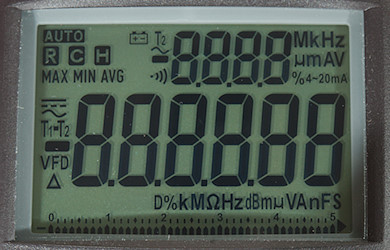
The above picture shows all the segments on the display.
There is a 4 digit, a 6 digit display and a bargraph. Only 5 of the 6 digits are usual used, in DCV it is possible to activate the last digit. The small display and the bargraph will only be used in some ranges, see end of this chapter.
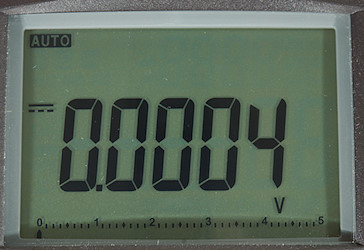
Normal DC voltage with voltage and bargraph.
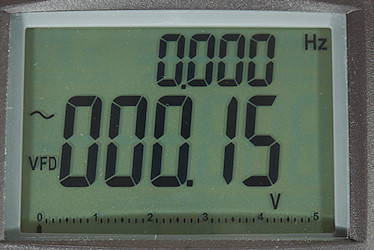
In some AC modes the small display will supplement the large display.
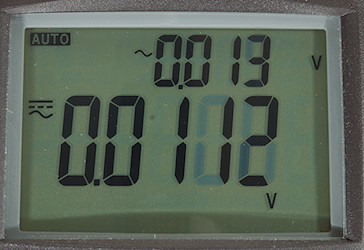
With this display the meter could not maintain the bargraph.
The bargraph will not be show when the secondary display shows voltage or current.
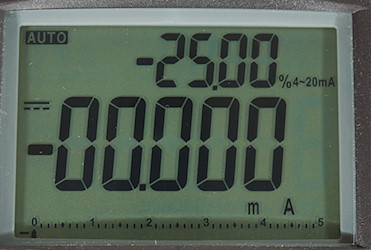
Current with a 4-20mA percent supplement.
Dual and single display functions (After / is small display):
VAC VFD: VAC/Hz, Hz/VAC
VAC: VAC/Hz, dBm/Hz, Hz/VAC
VDC: VDC, VDC/VAC, DC+AC/VAC
mVDC: mVDC, mVDC/mVAC, mDC+mAC/mVAC, Hz, Duty Cycle
mVAC: mVAC/Hz, dBm/Hz, Hz/mVAC
Temp: T1, T2, T1/T2, T1-T2/T2 (Use RANGE to select)
mA: mADC/%4-20mA, mADC/mAAC, mDC+mAC/mAAC, mAAC/Hz
A: ADC, ADC/AAC, DC+AC/AAC, AAC/Hz
uA: uADC, uADC/uAAC, uDC+uAC/uAAC, uAAC/Hz
Functions
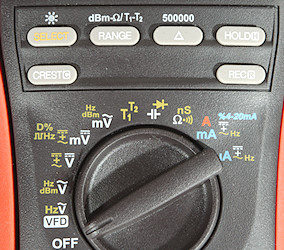
Buttons (Range selection and a few other are remembered):
-
Select (Yellow): Select between the different modes on each position of the range switch, hold down to activate background light. Meter will remember the selection and use it next time the range is selected.
-
Range: Switch to manual range and select range, hold down to activate automatic ranging again. In dB mode this button will select reference impedance from 20 different values, in temperature mode it will select different combinations of thermocouplers.
-
 : Shows values relative to current value. In VDC Hold down to activate 500000 count mode.
: Shows values relative to current value. In VDC Hold down to activate 500000 count mode. -
Crest: Peak mode, will record and show fast min/max. Use button to change between min/max. Hold down to end mode.
-
Rec: Minimum/maximum mode, will record min/max values. Use button to change between actual/max/min/average. Hold down to end mode.
Rotary switch:
-
Off: Meter is turned off.
-
VAC VFD: Measure AC voltage with a low pass filter, will also show frequency.
-
VAC: Measure AC voltage, frequency and dB
-
VDC: Measure DC voltage, AC voltage and AC+DC voltage.
-
mVDC: Millivolt range, measure DC voltage, AC voltage, AC+DC voltage, frequency and duty cycle.
-
mVAC: Millivolt range, measure AC voltage, frequency and dB
-
T1 T2: Measure temperature with one or two thermocouplers, can also show difference between them.
-
 : Capacitance and diode range.
: Capacitance and diode range. -
 : Resistance and continuity, the nS makes it possible to measure very huge resistance values.
: Resistance and continuity, the nS makes it possible to measure very huge resistance values. -
A mA: This is either mA or A depending on where the probe is connected. It will measure DCA, ACA, ACA+DCA, frequency and 4-20mA
-
uA: The uA range. It will measure DCA, ACA, ACA+DCA and frequency.
dB reference impedance: 4, 8, 16, 32, 50, 75, 93, 110, 125, 135, 150, 200, 250, 300, 500, 600, 800, 900, 1000, 1200
Input

-
A: High current, maximum current is 10A, also ground for second thermocoupler.
-
mAuA: The lower current ranges and + input for the second thermocoupler.
-
CON: The common terminal for all ranges.
-
xxx: All other ranges.
Measurements
-
Volt and frequency
-
500000 mode do not increase precision, only resolution. Normal readings do not round the extra digit.
-
Frequency input has a trigger point around 1.5V
-
At 1Vrms frequency input (mVAC) range is from 2Hz to 300kHz
-
At 3Vrms frequency input (mVAC) range is from 2Hz to 2.8MHz
-
At 100mVrms input on mVAC range, frequency range is from 2Hz to 800kHz
-
Duty cycle works from 3% to 99% at 100kHz with 4Vpp, precision is within 2.5
-
1 VAC is 5% down at 350kHz (RMS will not work at the frequency).
-
1 VAC with LPF (VFD) is 5% down at 530Hz.
-
Auto range works when doing min/max, peak and relative.
-
Max/min (Rec) needs about 350ms to capture a voltage.
-
Peak (Creast) needs about 0.7ms to capture a voltage.
-
Large AC values on DC ranges will prevent the meter from showing a value, except if dual display AC and DC is selected.
-
Input impedance is 10-11Mohm on DC
-
Both AC input has a capacitor
-
The DCV & DCmV range has two paths: Directly DC volt and True-RMS volt, they will not show exactly the same value. The 500000 readout can only be selected in the direct DC mode.
-
mV DC/AC has 10Mohm input impedance up to about 3V, then it drops to 20kohm at 10 volt and 4kOhm at 35 volt.
-
Frequency input is 10Mohm up to 3 volt then it drops to 20kohm at 10 volt and 4kOhm at 35 volt.
-
Rated overload protection on V ranges is 1100VDC/VAC and 12kV transient.
-
Rated overload protection is 1000VDC/VAC and 12kV transient in mV range .
-
-
Current
-
Overload protection in uA and mA: 0.44A/1000V 10x38mm fuse
-
Overload protection in A: 11A/1000V 10x38mm fuse
-
DCmA can show a secondary display with percent of 4-20mA range
-
There is an audible warning and display shows “InErr” when using non current ranges with a probe in mAuA or A input.
-
-
Ohm, continuity, diode and capacity
-
Ohm needs about 1.9s to measure 100ohm
-
Ohm is 1.15V open and 0.38mA shorted
-
Continuity is very fast (Below 10ms).
-
Continuity beeps when resistance is below 94ohm
-
Continuity is 2.9V open and 0.38mA shorted
-
Conductivity (nS) is 1.15V open and 1.1uA shorted
-
Diode range uses 2.94V, max. display is 2.0000V at 0.12mA, max. current is 0.38mA shorted
-
11000uF takes about 11 seconds to measure.
-
Rated overload protection is 1000VDC/VAC and 12kV transient.
-
-
Miscellaneous
-
Current consumption of meter is 5mA-7mA (30mA with backlight)
-
Meter works down to 5.6V where it says “InErr”, battery symbol show at 6.3V.
-
The meter reading is stable until it reports “InErr”.
-
Backlight is stable until meter reports “InErr”.
-
The meter sometimes need a couple of updates before the reading is fully correct.
-
Viewing angle is good
-
Display updates around 5 times/sec (1.25 times/sec in high-res mode).
-
Bargraph updates 60 times/sec
-
Backlight will turn off in 15 seconds
-
Will automatic turn power off in about 17 minutes without any warning.
-
Standard probes fits perfectly into sockets on meter.
-
Weight is 642g without accessories, but with batteries.
-
Size is 210 x 103 x 64mm.
-
-
Probes
-
Probe resistance 26mOhm for one.
-
Probe wire is soft and 100cm long.
-

A look at the capacity measurement waveform.

Frequency input resistance, this is similar to mV

Software
The software must be bought separately.
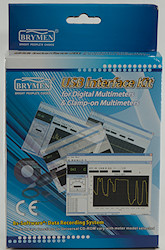

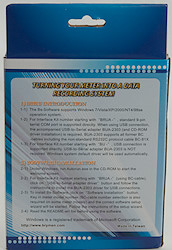

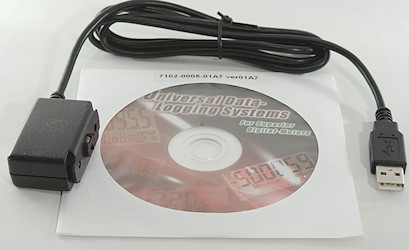
The box only includes a cable and a CD. The CD contains software for many different meters and also files describing the data format (It is the display segments, not digits that is transmitted).

The opto adapter has two leds and some mechanic to lock it securely in place.
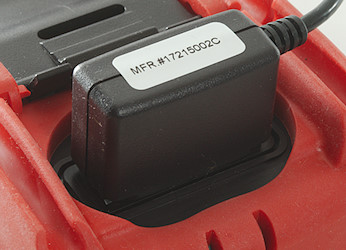
Here it is mounted on the meter.

The software is one top bar and initially four independent windows.

Here I am connected to the meter and read data.
The data can be saved from the chart window in either an internal format or exported to a image or CSV file.

The different windows in the meter software can be closed and moved independent, except the title and command bar.

Here is the export dialog. There is another menu to adjust the logging interval.

The CSV file is fairly easy to read.
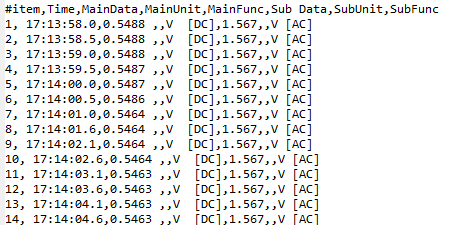
And if the meter is using the dual display it will log two sets of data for each line.
Tear down
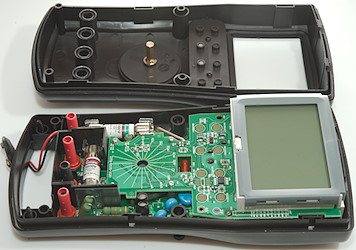
4 screws and the front could be removed (This time it was not the back). The screws do not fall out, but stays in the holes.
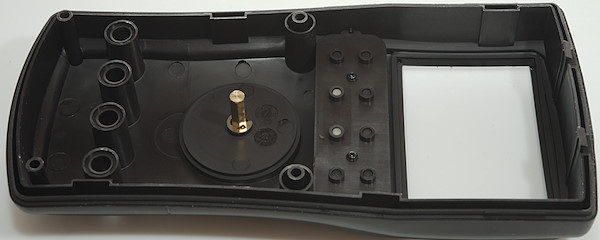
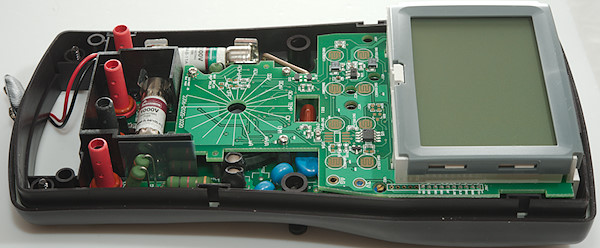
There are pads for 8 buttons, but the meter only has 6 buttons? There is also space for an extra chip.
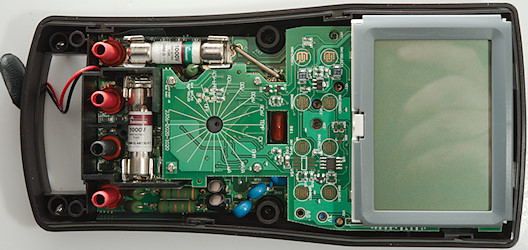
On this image it is possible to see that the missing buttons are marked UP and DOWN
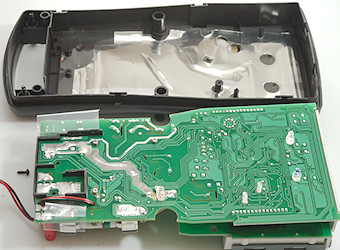
To get the electronic out I had to remove one more screws (There are holes for two).
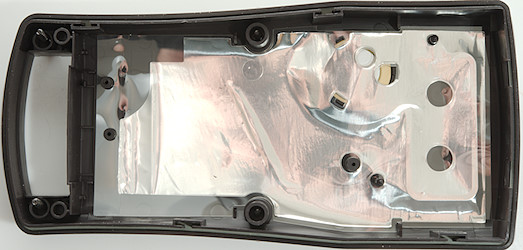
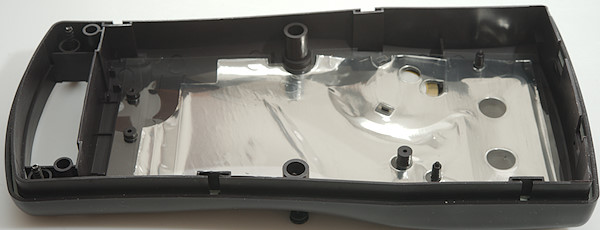
The back of meter is shielded and the buzzer is mounted outside the shield.
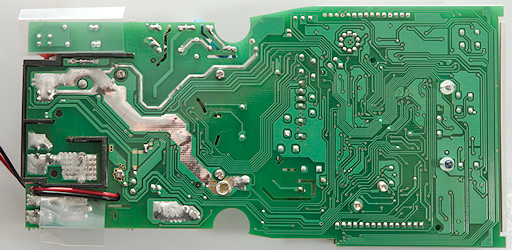
On this side there are a couple of springs for connection to the shield and buzzer and also two leds for the computer link.

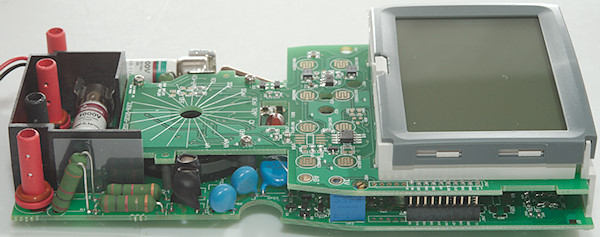

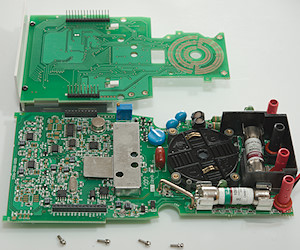
I had to remove four screws around the range switch to take the two circuit boards apart.
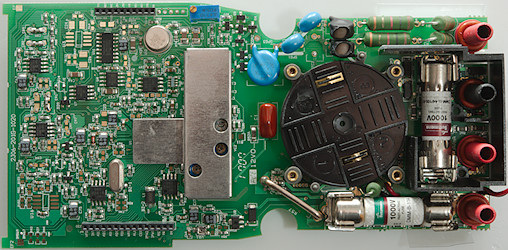
Around the center fuse (0.44A) is four diodes for protection of the mA and uA shunts, there is also the input terminal sense resistors (R6abcdef: 6x2Mohm). The ones for the 10A range is below the 10A fuse.
The voltage input has two paths with resistors (R1 & R2 and R3 & R4) each followed by a ptc (PTC3 & PTC?) and clamped to minus by some MOVS (SPG1 & SPG2 + SPG3). There is also 3 pairs of transistors (Q3 & Q4, Q5 & Q6, Q7 & Q8) that can be switched in.
The voltage divider and multimeter chip is below the shield, that is soldered to the circuit board. The big capacitor (C1) is the AC input capacitor.
Some interesting chips are the reference (U4: REF43G), a analog switch (U11: 74HC4053D), a voltage converter (U7: HT7660), a OpAmp (U14 & U15: MCP602I), rms to dc converter (U12: AD636JHZ).
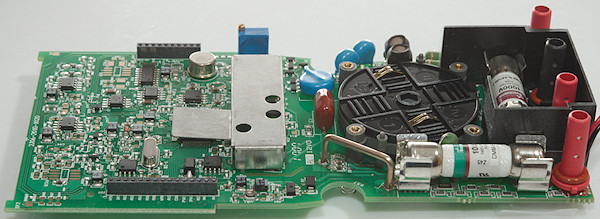
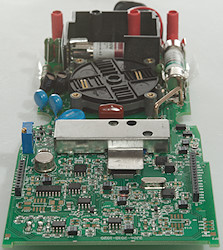
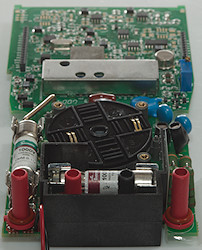
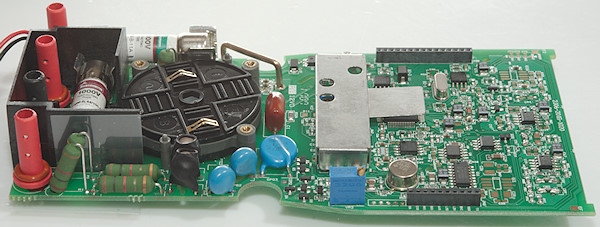
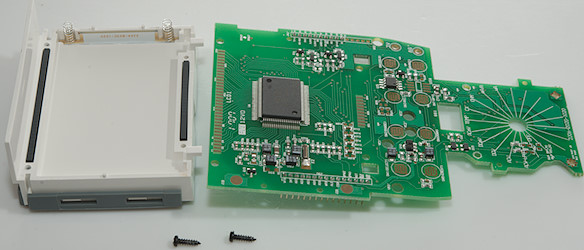
Two screws more and I could pull the display off.
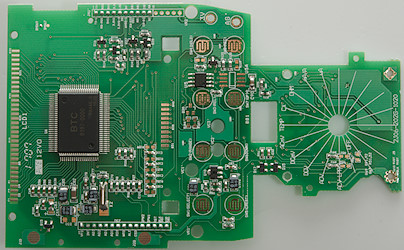
On this board is the main processor and a EEPROM to store calibration (U5: S24CS04A)
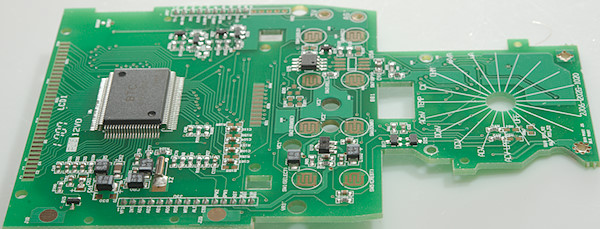
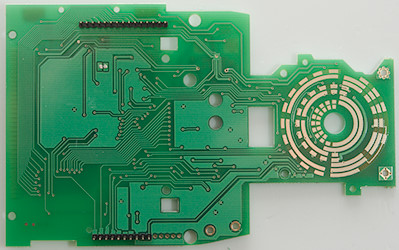
Only the connectors and the range switch on this side. The range switch is a bit interesting, it has 8 circles of contact points, but in the range switch there is only switches to cover 4 circles?
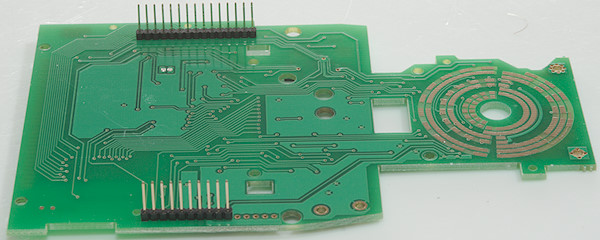
Conclusion
This meter has a lot of protection and mounted the right way, it do also have very large fuses.
All the common ranges are present and also a lot of extra functions like Peak, Average, Dual-display, AC+DC. This makes it a very universal high end meter with just about any desired function. In the volt ranges the range switch is a bit overloaded (All 5 volt ranges can measure AC) and it may take some time to get it straighten out what range to use for what with AC, all other ranges are logical enough.
The meter is not really specialized for electrician, industrial, HVAC, audio or electronic, but is mostly perfect for all of it (The missing Low-Z mode may give a minus point for some areas).
Notes
How do I review a DMM
More DMM reviews